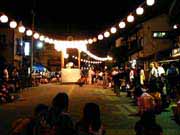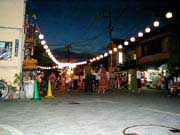Schedule, Program
Schedule
Tsukudajima Bon Dancing is held from July 13 to 15 every year. With the introduction of the solar calendar in Meiji , the Bon season in Tokyo area which is the “home of the emperor” became July in solar calendar. Tsukudajima Nembutsu Dancing followed this, and shifted the festival period from July in lunar calendar to July in solar calendar. As a result, it became one of the representative Bon Dancings in the Metropolitan area that we can enjoy in July.
Program
People start dancing from the evening and keep dancing until 9 PM. The first half is children’s part and local schoolchildren including those from Tsukudajima Elementary School dance while shouting cheerfully. It seems that the chorus and drums have become a chance to practice for the young successors.
There is a break after the end of the first half. Children receive prizes (sweets) for participating in the festival, and the conservation association explains about the origin of Nembutsu Dancing.
The latter half is a time for adult’s dance. Headliner of the chorus leader come onstage and creates a splendid atmosphere.
Children listen to the explanation of the origin in the recess.
Location of the Dance
They dance around the street of Tsukudajima 1 choume. 10 minutes walk from Tsukishima area. After you cross the red-painted “Tsukuda Kouhashi”, you come to the main street of Tsukudajima 1 choume.
The street is rather wide, and this is the place of Bon Dancing. There is a scaffold in the center and lanterns are spread to all directions.
There is a lot of familiar mood since this is a place of communication for the local people.
People head for the dancing venue
Facilities
Scaffold
A scaffold, the symbol of Bon Dancing is set up in the center of the street, and people dance around this.
A big drum is set onstage of the scaffold, and one of the chorus leader beats the drum and sings the chorus.
There is a bucket under the scaffold so the chorus leader and dancers can drink water.
Lantern
Besides the lanterns that light up the venue which spreads in all directions from the scaffold, lanterns are decorated under the eaves of houses around. Generally, lanterns of Bon Dancing are considered as a sign for the spirits that come back in Bon season, and these lanterns are thought to have such meanings.
Lanterns under the eaves
Shelf for the spirits (for the people who died leaving no one to attend to their grave)
The impressive thing of Nembutsu Dancing in Tsukudajima is that it has not become a modern Bon Dancing which aims to have only fun, but that you can still feel the soul of folk belief of the ancient people as a shape. “Shelf for the spirits” which is set in the corner of the scaffold facing Sumida River is a good example. A kakemono written “Muen Botoke (people who died leaving no one to attend to their grave)” is hung in the shelf, and vegetables such as pumkins and cucumbers are offered.
Participants and visitors offer incense sticks and pray in the intervals of Bon Dancing. We can observe that the Bon Dancing is danced towards the Muen Botoke.
The shelf for the spirits is made for the repose of the spirits of the people who died by drowning in Sumida River and Tokyo Bay. Tsukudajima is located in the junction of the flow of Sumida River, and it is a place where bodies were washed ashore when there was a disaster in the upper stream. As we can see by this fact, the existence of the shelf for the spirits clearly shows that Tsukudajima Nembutsu Dancing has a charcter as a Nembutsu Dancing to hold a memorial service for the “Muen Botoke”, and this is noteworthy.
Muen Botoke and the people who pray





